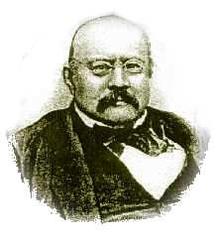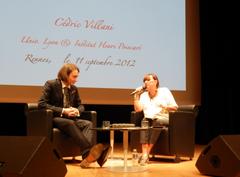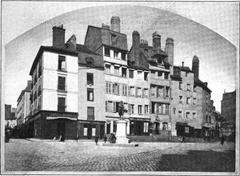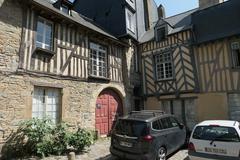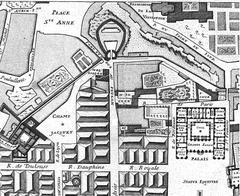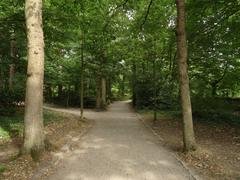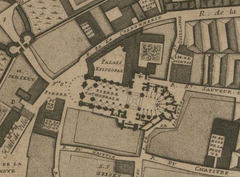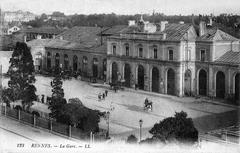Jacques-Cartier Prison Rennes: Visiting Hours, Tickets & Historical Sites Guide
Date: 04/07/2025
Introduction
Jacques-Cartier Prison, located in the heart of Rennes, France, is both a striking architectural landmark and a powerful symbol of the city’s social and political history. Constructed between 1898 and 1903 by architect Jean-Marie Laloy, this former penitentiary reflects the evolution of French penal philosophy, the traumas of mid-20th-century conflict, and the ongoing transformation of urban spaces into vibrant centers of culture and civic engagement. Closed in 2010 and now under the stewardship of Rennes Métropole, Jacques-Cartier Prison is being reimagined as a site of memory, artistic expression, and community renewal.
Whether you are a history enthusiast, architecture aficionado, or a traveler eager to explore Rennes’ unique heritage, this guide offers a comprehensive look at the prison’s origins, its wartime significance, visitor information, accessibility, and its role in contemporary Rennes. Dive in to uncover the layers of justice, resilience, and renewal within this monumental site (Amis du Patrimoine Rennais, PDF; Rennes Urban Trail; France 3 Régions).
Table of Contents
- Introduction
- Historical Overview
- Jacques-Cartier Prison in Urban & Social History
- Visiting Information: Hours, Tickets & Tours
- Architectural Features and Visitor Experience
- Accessibility, Booking & Tips
- Ongoing Developments & Community Projects
- FAQ
- References and Further Reading
Historical Overview
Origins and Construction (1898–1903)
The decision to build Jacques-Cartier Prison arose during a period of rapid urban expansion in Rennes. Seeking a more modern, hygienic, and secure facility, city planners selected an elevated site on the city’s southern edge, symbolically projecting the authority of the state (Amis du Patrimoine Rennais, PDF). Jean-Marie Laloy’s design followed the panopticon model: a central rotunda 25 meters high, three radiating wings for maximum surveillance, and an emphasis on inmate isolation. The building’s purple schist façade, rose window, and functional yet imposing forms echo Rennes’ architectural heritage.
The original facility comprised 177 cells (135 for men, 42 for women), with amenities such as heating, gas lighting, and running water—advanced for its time. Exercise yards were strictly separated, enforcing the prevailing philosophy of solitary confinement (Autrefois Rennes).
Early 20th Century: Justice and Punishment
Jacques-Cartier Prison quickly became the primary detention center for Ille-et-Vilaine. It also witnessed public executions by guillotine in 1922 and 1939, underscoring its role in the visible administration of justice (Rennes Urban Trail). The prison’s capacity grew over the decades, reaching 326 cells and housing nearly 500 inmates by the time of its closure.
World War II and the “Années Sombres” (1940–1947)
Under German occupation, the prison was requisitioned by Nazi authorities. It became a site of detention, interrogation, and torture for resistance fighters, political prisoners, and persecuted minorities. Personal stories from this era—such as those of Yvonne G., Marcel Helleu, and Lucie Sée—highlight the prison’s central role in wartime repression and the suffering endured (Champs de Justice; Rennes Maville). The “années sombres” are commemorated through exhibitions and educational efforts.
Postwar Years and Late 20th Century
After WWII, Jacques-Cartier returned to its function as a maison d’arrêt for men, with periodic expansions and renovations (1971, 1980, 1997) to address prison overcrowding and evolving standards (France 3 Régions). Despite these updates, the facility’s condition deteriorated, and its central urban location became increasingly incongruent with modern city planning (Amis du Patrimoine Rennais, PDF).
Closure and Heritage Status (2010–Present)
In March 2010, the prison was officially closed and its inmates transferred to a new penitentiary at Vezin-le-Coquet (Autrefois Rennes; Rennes Urban Trail). Rennes Métropole acquired the site in 2021, ensuring its preservation and embarking on a participatory project to transform it into a cultural and civic hub (France 3 Régions; Rennes Urban Trail).
Jacques-Cartier Prison in Urban & Social History
Throughout its existence, Jacques-Cartier Prison has mirrored the shifts in Rennes’ urban landscape and societal attitudes towards incarceration, justice, and rehabilitation. Once isolated on the city’s edge, it is now enveloped by bustling neighborhoods, symbolizing the tension between containment and community. Its adaptive reuse as a cultural landmark ensures its history remains accessible and relevant (Ille-et-Vilaine Tourisme).
Visiting Information: Hours, Tickets & Tours
Opening Hours
- European Heritage Days & Special Events: Usually 10:00 AM to 6:00 PM; check the official tourism portal or dimanche.rennes.fr for current schedules.
- Regular Visits: Outside of event days, the site is generally closed to the public except for booked tours and exhibitions.
Tickets
- General Admission: Free during open days and European Heritage Days.
- Guided Tours & Special Exhibitions: May require advance booking and a modest fee; see Rennes Métropole for updates.
Guided Tours
- Languages: Primarily in French; English explanations may be available on request.
- Duration: 1–2 hours.
- Content: In-depth exploration of architecture, history, and personal stories. Some tours grant access to restricted areas and include multimedia or interactive elements (Evendo).
Accessibility
- Mobility: The site is partially accessible; some areas (upper floors, narrow staircases) may pose challenges.
- Facilities: Restrooms and adapted amenities are available during events and guided visits (Pézenas Voyages).
- Contact: For specific needs, contact the visitor center in advance.
Architectural Features and Visitor Experience
Layout and Design
- Exterior: The purple schist façade and high perimeter walls define the prison’s imposing presence.
- Entrance: A heavy, arched gateway separates city life from the interior world of the prison.
- Interior: Central rotunda, radiating cell blocks, and compact cells (7–9 m²), each with high-barred windows and reinforced doors (nouvelles.univ-rennes2.fr).
- Courtyard: Once used for inmate exercise, now hosts exhibitions and performances during public events.
Visitor Engagement
- Exhibitions: Explore reconstructions of historical cells and curated panels on WWII, resistance, and the prison’s social ecosystem.
- Interactive Elements: Multimedia installations, video projections, soundscapes, and participatory art projects enhance the experience (Pézenas Voyages).
- Photography: Permitted in most areas; flash and tripods may be restricted.
Accessibility, Booking & Tips
- Advance Booking: Strongly recommended for European Heritage Days and guided tours due to high demand (Rennes Infos Autrement).
- Best Times: Early or late in the day to avoid queues. Allow 1–2 hours for a full visit.
- Language: French is predominant; check for English-language tours if needed.
- Nearby Attractions: Rennes Cathedral, Parlement de Bretagne, Parc du Thabor, and the city’s historic center are all nearby.
Ongoing Developments & Community Projects
Since its closure, Jacques-Cartier Prison has become a focal point for participatory urban renewal. Rennes Métropole’s citizen project encourages local input through workshops, artistic residencies, and ecological initiatives—transforming former spaces of punishment into gardens, art venues, and community gathering points (Manifesto). A major redevelopment is planned for completion by 2025, with interim exhibitions and events giving the public ongoing access (Le Télégramme).
Frequently Asked Questions (FAQ)
Q: Can I visit any time of year?
A: Public access is generally limited to special events and guided tours; check event calendars for details.
Q: Are tickets required?
A: Entry is free during open days, but guided tours and exhibitions may require prior booking.
Q: Is the site accessible for people with disabilities?
A: The prison is partially accessible. Some areas may be difficult to reach; contact the visitor center for specific information.
Q: In what language are tours conducted?
A: Most tours are in French, with some English explanations available on request.
Q: Can I take photos?
A: Photography is permitted in most areas; check event-specific guidelines.
References and Further Reading
- Amis du Patrimoine Rennais, 2011, ‘Historique de la prison Jacques Cartier’
- Rennes Urban Trail, n.d., ‘La prison Jacques-Cartier’
- France 3 Régions, 2021, ‘Rennes: l’ancienne prison Jacques Cartier sera transformée en espace culturel’
- Champs de Justice, 2025, ‘Exposition au Parlement de Bretagne: Justice des années sombres Jacques-Cartier 1940-1947’
- Rennes Infos Autrement, 2023, ‘Journées du patrimoine: quatre visites à ne pas rater’
- Ici Rennes, 2025, ‘Jacques Cartier: de prison à projet citoyen’
- Autrefois Rennes
- Wiki Rennes
- Pézenas Voyages
- Evendo
- Frank Falla Archive
- Wikipedia
- Manifesto
- Le Télégramme
- nouvelles.univ-rennes2.fr
- Ille-et-Vilaine Tourisme
- dimanche.rennes.fr
Summary & Recommendations
Jacques-Cartier Prison stands today as a testament to Rennes’ evolving relationship with justice, memory, and community. Its layered history—from architectural innovation and wartime suffering to its rebirth as a cultural space—offers visitors an immersive, thought-provoking experience. Plan your visit around special events or guided tours, and allow time to explore the site’s exhibitions and the vibrant neighborhoods nearby.
For the latest visiting details, event schedules, and cultural programming, visit the official Rennes tourism portal. Enhance your experience with audio guides from the Audiala app, and follow local channels for updates on exhibitions and participatory projects.
Experience the transformation of a place once defined by walls—now open to the city, its stories, and its future.
